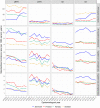Hospital Contacts for Infectious Diseases Among Children in Denmark, Finland, Norway, and Sweden, 2008-2017
- PMID: 35520276
- PMCID: PMC9063804
- DOI: 10.2147/CLEP.S355193
Hospital Contacts for Infectious Diseases Among Children in Denmark, Finland, Norway, and Sweden, 2008-2017
Abstract
Purpose: Comparing rates of childhood infectious disease hospitalisations across countries may uncover areas for improvement in the prevention of severe childhood infections. We compared rates of childhood infectious disease hospital contacts across Denmark, Finland, Norway, and Sweden with the overall objective to elucidate potential differences in burden of disease and in organisational and registration practices.
Methods: Using national registries, we estimated incidence rates for infectious disease hospital contacts between 2008 and 2017 among children aged 0-14 years. We investigated the rates for different types of contacts (inpatient or outpatient including emergency room), duration of admission, and by sex.
Results: During the study period, the rate of all hospital contacts per 1000 person-years was highest in Sweden (125.2) followed by Finland (87.1), Denmark (79.0), and Norway (62.1). The rates aligned for inpatient contacts with overnight stays; 19.3 (Denmark), 16.6 (Finland), 16.3 (Norway), and 13.0 (Sweden); these were highest in early infancy in all countries. A peak around 1 year of age was seen in all countries except in Sweden. The rates were higher among boys compared with girls in early childhood, after 13 years of age the rates among girls surpassed the boys.
Conclusion: Large cross-country differences were observed for outpatient and short-term hospital contacts for infectious diseases, affected by differences in organisational structures and coding practices across and within countries over time. Inpatient contacts requiring overnight stays reflected more comparable levels of severe infections across countries. Childhood infectious disease morbidity was greatest among boys and before 2 years of age.
Keywords: Nordic countries; infectious disease hospitalisations; multinational study; paediatric; patient registry.
© 2022 Gehrt et al.
Conflict of interest statement
AAP and HN are investigators in vaccine-related studies for which THL has received funding from GSK, Pfizer and Sanofi Pasteur. Dr Signe Sørup reports grants from NordForsk, during the conduct of the study. The remaining authors report no relation that could be construed as a conflict of interest.
Figures





Similar articles
-
Trends in cancer incidence in the Nordic countries. A collaborative study of the five Nordic Cancer Registries.Acta Pathol Microbiol Immunol Scand Suppl. 1986;288:1-151. Acta Pathol Microbiol Immunol Scand Suppl. 1986. PMID: 3465196
-
Trends in childhood asthma in Denmark, Finland, Norway and Sweden.Acta Paediatr. 2025 Jun;114(6):1329-1337. doi: 10.1111/apa.17573. Epub 2025 Jan 13. Acta Paediatr. 2025. PMID: 39803879 Free PMC article.
-
Long-term inpatient disease burden in the Adult Life after Childhood Cancer in Scandinavia (ALiCCS) study: A cohort study of 21,297 childhood cancer survivors.PLoS Med. 2017 May 9;14(5):e1002296. doi: 10.1371/journal.pmed.1002296. eCollection 2017 May. PLoS Med. 2017. PMID: 28486495 Free PMC article.
-
Work-related cancer in the Nordic countries.Scand J Work Environ Health. 1999;25 Suppl 2:1-116. Scand J Work Environ Health. 1999. PMID: 10507118 Review.
-
Effects of alcohol controls: Nordic research traditions.Drug Alcohol Rev. 2004 Mar;23(1):43-53. doi: 10.1080/095952304100001645547. Drug Alcohol Rev. 2004. PMID: 14965886 Review.
Cited by
-
Cohort Profile: Childhood morbidity and potential non-specific effects of the childhood vaccination programmes in the Nordic countries (NONSEnse): register-based cohort of children born 1990-2017/2018.BMJ Open. 2023 Feb 10;13(2):e065984. doi: 10.1136/bmjopen-2022-065984. BMJ Open. 2023. PMID: 36764731 Free PMC article.
-
Early-Life Infections, Antibiotics and Later Risk of Childhood and Early Adult-Onset Inflammatory Bowel Disease: Pooled Analysis of Two Scandinavian Birth Cohorts.Aliment Pharmacol Ther. 2025 Jan;61(2):323-334. doi: 10.1111/apt.18358. Epub 2024 Oct 25. Aliment Pharmacol Ther. 2025. PMID: 39450871 Free PMC article.
-
Infectious disease hospitalization after receipt of human papillomavirus vaccine: a nationwide register-based cohort study among Danish, Finnish, Norwegian, and Swedish girls.Eur J Epidemiol. 2025 Jan;40(1):81-93. doi: 10.1007/s10654-024-01197-3. Epub 2025 Jan 6. Eur J Epidemiol. 2025. PMID: 39760962 Free PMC article.
-
Associations between multiple perinatal exposures and risk of childhood hospitalisation with infection: a registry-based study in two countries.Eur J Epidemiol. 2025 Aug 13. doi: 10.1007/s10654-025-01266-1. Online ahead of print. Eur J Epidemiol. 2025. PMID: 40801990
References
-
- World Health Organization. Vaccines and immunization: what is vaccination?; 2021. Available from: https://www.who.int/news-room/q-a-detail/vaccines-and-immunization-what-.... Accessed April 16, 2022.
LinkOut - more resources
Full Text Sources

